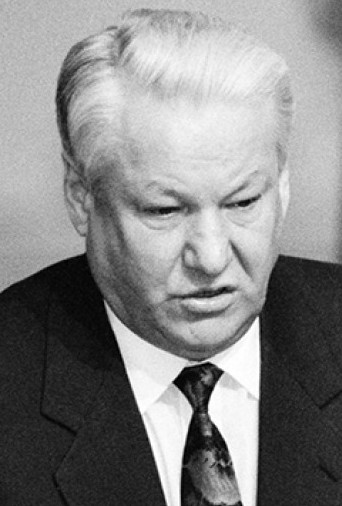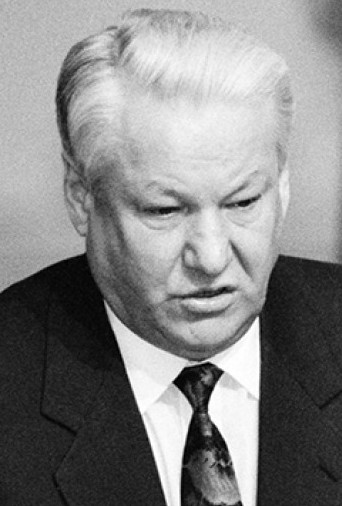


Boris Yeltsin (1931–2007) was the first President of the Russian Federation, serving from 1991 to 1999. Yeltsin was a key figure in the dissolution of the Soviet Union and played a central role in transforming Russia from a communist system to a market-based democracy. His presidency was marked by significant political and economic upheaval, including efforts to implement free-market reforms, the rise of oligarchs, the Chechen Wars, and increasing political instability. Yeltsin's leadership style, characterized by bold and often unpredictable decisions, made him a polarizing figure in both Russia and the international community. He resigned on December 31, 1999, handing power to Vladimir Putin, who became his successor.
Birth and Family Background: Boris Nikolayevich Yeltsin was born on February 1, 1931, in the village of Butka, located in the Ural Mountains region of Russia, which was part of the Soviet Union at the time. His family was of modest means, and Yeltsin experienced the hardships of rural Soviet life under Joseph Stalin's rule. His father was imprisoned for "anti-Soviet" activities during Stalin’s purges, which left a lasting impact on Yeltsin.
Education: Yeltsin studied civil engineering at the Ural Polytechnic Institute in Sverdlovsk (now Yekaterinburg), where he graduated in 1955. After completing his education, Yeltsin worked as a construction engineer and quickly rose through the ranks of the local Communist Party.
Early Political Career: Yeltsin’s political career began in Sverdlovsk, where he became known for his no-nonsense approach to governance and a reputation as a tough reformer. By 1976, he had become the First Secretary of the Communist Party in Sverdlovsk, which put him in charge of the region. His success in regional governance earned him recognition from the national leadership.
Move to Moscow: In 1985, Mikhail Gorbachev, the General Secretary of the Communist Party, brought Yeltsin to Moscow, appointing him as the head of the Moscow City Party Committee. Initially, Yeltsin supported Gorbachev’s reforms of perestroika (economic restructuring) and glasnost (political openness). However, Yeltsin soon grew frustrated with the slow pace of reforms and became critical of the Communist Party’s leadership, leading to his dismissal from the Politburo in 1987.
Champion of Reform and Opposition to the Soviet Establishment: By the late 1980s, Yeltsin had become a vocal critic of the Soviet system and positioned himself as a populist reformer. He was elected to the Soviet Union’s Congress of People's Deputies in 1989, gaining widespread support for his push for greater political and economic freedom. In 1990, he was elected chairman of the Russian Soviet Federative Socialist Republic’s Supreme Soviet, making him the de facto leader of Russia within the Soviet Union.
1991 Coup and the Collapse of the Soviet Union: In August 1991, hardline members of the Communist Party attempted to overthrow Gorbachev in a coup. Yeltsin famously stood atop a tank outside the Russian parliament building (the White House) and called on the people to resist the coup. His defiance became a symbol of resistance to Soviet authoritarianism. The coup collapsed, and Yeltsin’s popularity soared.
In the aftermath of the failed coup, Yeltsin worked to dismantle the Soviet Union. On December 25, 1991, Mikhail Gorbachev resigned as president of the Soviet Union, and the USSR was formally dissolved. Yeltsin became the first President of the Russian Federation, marking the beginning of post-Soviet Russia.
Economic Reforms and Shock Therapy: One of Yeltsin’s top priorities as president was transforming Russia’s economy from a state-controlled system to a market economy. His government implemented a series of radical economic reforms, often referred to as "shock therapy," which included the rapid privatization of state-owned enterprises, the liberalization of prices, and efforts to integrate Russia into the global economy.
While these reforms were intended to stimulate growth and reduce inefficiency, they led to widespread economic chaos. Hyperinflation eroded the savings of ordinary Russians, and living standards plummeted. The privatization process also gave rise to a new class of oligarchs, wealthy individuals who acquired vast state assets at low prices, further fueling economic inequality and corruption.
Political Challenges and the 1993 Constitutional Crisis: Yeltsin’s presidency was marked by political instability, including a violent showdown between the president and parliament in 1993. The parliament, controlled by opponents of Yeltsin’s reforms, sought to limit his powers, and in response, Yeltsin dissolved the legislative body. When the parliament refused to disband, Yeltsin ordered the military to shell the Russian parliament building (the White House), resulting in the deaths of over 100 people. Following this crisis, Yeltsin pushed through a new constitution that expanded presidential powers, though the violence damaged his reputation.
Chechen Wars: One of the darkest chapters of Yeltsin’s presidency was the First Chechen War (1994–1996). Chechnya, a Muslim-majority republic in the North Caucasus, sought independence from Russia, leading Yeltsin to launch a military intervention. The war was brutal, with significant civilian casualties and widespread destruction. The conflict ended in a ceasefire in 1996, but Chechnya remained a volatile region, and the war severely weakened Yeltsin’s popularity.
Relationship with the West: Yeltsin initially pursued closer ties with the West, particularly the United States. He sought Western financial aid and embraced Russia’s integration into the global economy. His relationship with U.S. President Bill Clinton was friendly, and Russia became part of the Group of Eight (G8). However, tensions emerged over NATO’s expansion into Eastern Europe, which Yeltsin and many Russians viewed as a threat to Russia’s security interests.
Health Problems and Declining Popularity: Yeltsin’s health deteriorated significantly during his presidency. He suffered from heart disease and had multiple heart surgeries, and his absences from public life fueled speculation about his ability to govern. His erratic behavior, including instances of public drunkenness, further eroded his credibility, and his approval ratings plummeted.
Re-Election in 1996: Despite his declining popularity, Yeltsin won re-election in 1996, defeating his communist rival Gennady Zyuganov in a closely contested race. However, the election was marred by allegations of media manipulation and heavy financial backing from the oligarchs who had benefited from Yeltsin’s privatization policies.
Resignation and Transfer of Power to Putin: By the late 1990s, Yeltsin’s presidency was marked by increasing instability, economic difficulties, and a lack of public support. On December 31, 1999, Yeltsin made a surprise announcement, resigning from the presidency and naming his then-Prime Minister, Vladimir Putin, as his successor. In his resignation speech, Yeltsin expressed regret for the hardships Russians had endured during his presidency and asked for forgiveness.
Yeltsin’s resignation paved the way for Putin’s rise to power, and Putin was elected president in March 2000. In return for Yeltsin’s resignation, Putin granted him immunity from prosecution for any potential crimes committed while in office.
Economic and Political Transition: Yeltsin’s legacy is deeply intertwined with Russia’s tumultuous transition from communism to capitalism and democracy. On one hand, he is credited with dismantling the Soviet Union and introducing democratic reforms, such as free elections and a free press, into Russia. On the other hand, his economic policies led to widespread poverty, corruption, and the rise of oligarchs, leaving many Russians disillusioned with democracy and capitalism.
Impact on Russian Society: Yeltsin’s presidency saw the emergence of a new class of oligarchs and widespread economic inequality. His handling of the privatization process is often criticized for allowing a small group of individuals to amass enormous wealth, while millions of Russians saw their living standards decline. This economic turmoil left a deep mark on Russian society and contributed to the rise of authoritarianism under his successor, Vladimir Putin.
Mixed Legacy: Yeltsin remains a highly polarizing figure in Russia. While some view him as a reformer who brought democracy to Russia and ended the Soviet Union’s authoritarian regime, others blame him for the economic and social chaos of the 1990s. His tenure is often remembered as a period of hardship for ordinary Russians, and his close association with the oligarchs further tarnished his image.
Vladimir Putin’s Rise to Power: Perhaps Yeltsin’s most lasting legacy is his decision to hand over power to Vladimir Putin. While Yeltsin envisioned a more democratic Russia, his successor’s policies have moved the country in a more authoritarian direction, with Putin consolidating power over the political system and curbing democratic freedoms.
Boris Yeltsin’s presidency was a transformative but deeply troubled period in Russian history. He presided over the dissolution of the Soviet Union and the creation of a new, democratic Russian state, but his tenure was also marked by economic turmoil, political conflict, and the rise of powerful oligarchs. While Yeltsin’s role in ending the Cold War and dismantling the Soviet Union is widely acknowledged, his legacy in Russia is mixed, with many viewing him as a leader who, despite his intentions, oversaw a period of national decline and hardship. His decision to appoint Vladimir Putin as his successor has had profound implications for Russia’s political trajectory in the decades since his resignation.

We use cookies
We use cookies and other tracking technologies to improve your browsing experience on our website, to show you personalized content and targeted ads, to analyze our website traffic, and to understand where our visitors are coming from. Privacy Policy.